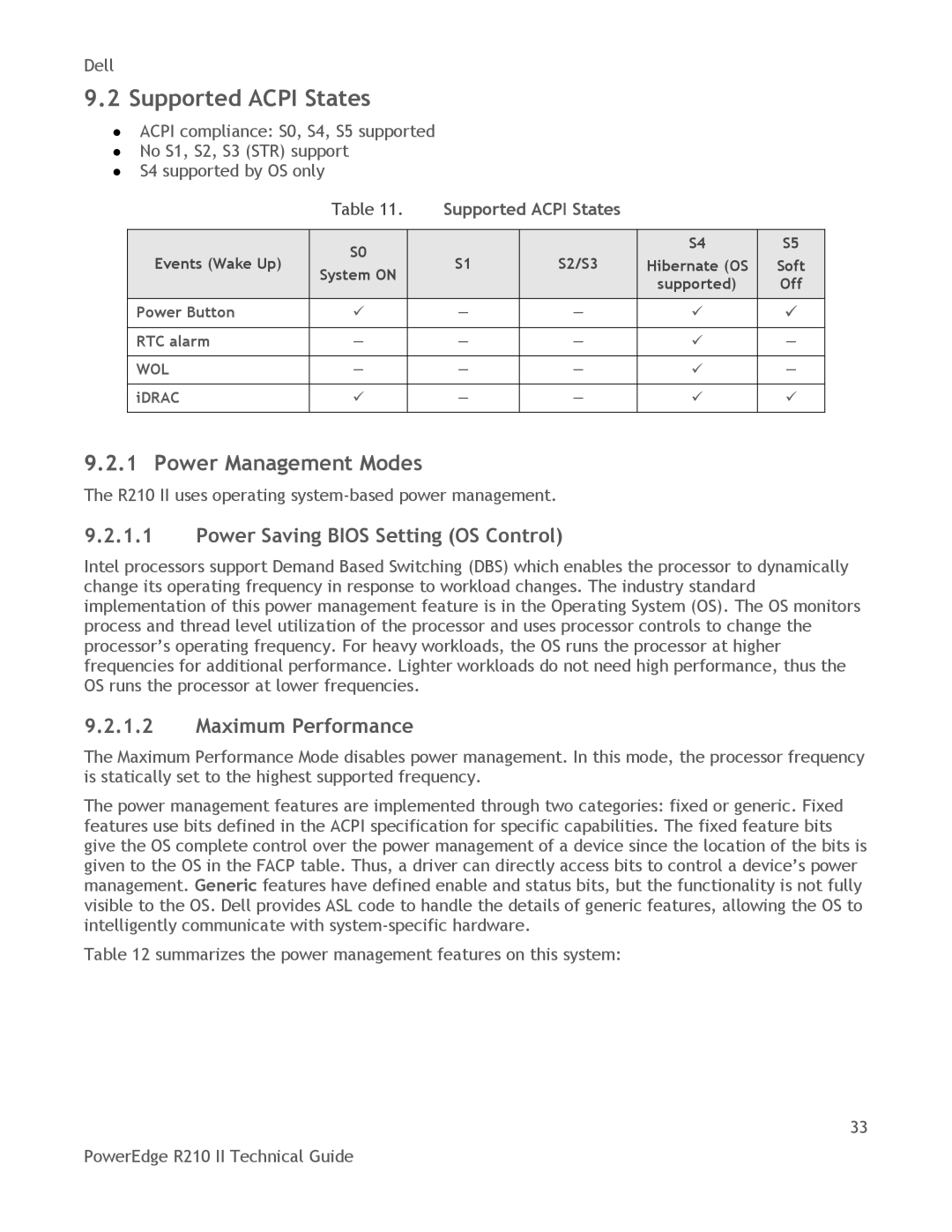Dell
9.2Supported ACPI States
●ACPI compliance: S0, S4, S5 supported
●No S1, S2, S3 (STR) support
●S4 supported by OS only
|
|
|
| Table 11. |
| Supported ACPI States |
|
|
|
|
|
| |||||
|
|
|
|
|
|
|
|
|
|
|
|
|
|
|
|
|
|
| Events (Wake Up) |
|
| S0 |
|
| S1 |
|
| S2/S3 |
|
| S4 |
|
| S5 |
|
|
|
|
|
|
|
|
|
| |||||||||
|
|
|
|
|
|
|
|
| Hibernate (OS |
|
| Soft |
| ||||
|
|
| System ON |
|
|
|
|
|
|
|
|
| |||||
|
|
|
|
|
|
|
|
|
|
|
| supported) |
|
| Off |
| |
|
|
|
|
|
|
|
|
|
|
|
|
|
|
|
| ||
|
|
|
|
|
|
|
|
|
|
|
|
|
|
|
|
| |
Power Button |
| |
| — |
| — |
| |
|
| |
| |||||
|
|
|
|
|
|
|
|
|
|
|
|
| |||||
RTC alarm |
| — |
| — |
| — |
| |
|
| — |
| |||||
|
|
|
|
|
|
|
|
|
|
|
|
| |||||
WOL |
| — |
| — |
| — |
| |
|
| — |
| |||||
|
|
|
|
|
|
|
|
|
|
|
|
| |||||
iDRAC |
| |
| — |
| — |
| |
|
| |
| |||||
|
|
|
|
|
|
|
|
|
|
|
|
|
|
|
|
|
|
9.2.1 Power Management Modes
The R210 II uses operating
9.2.1.1Power Saving BIOS Setting (OS Control)
Intel processors support Demand Based Switching (DBS) which enables the processor to dynamically change its operating frequency in response to workload changes. The industry standard implementation of this power management feature is in the Operating System (OS). The OS monitors process and thread level utilization of the processor and uses processor controls to change the processor‘s operating frequency. For heavy workloads, the OS runs the processor at higher frequencies for additional performance. Lighter workloads do not need high performance, thus the OS runs the processor at lower frequencies.
9.2.1.2Maximum Performance
The Maximum Performance Mode disables power management. In this mode, the processor frequency is statically set to the highest supported frequency.
The power management features are implemented through two categories: fixed or generic. Fixed features use bits defined in the ACPI specification for specific capabilities. The fixed feature bits give the OS complete control over the power management of a device since the location of the bits is given to the OS in the FACP table. Thus, a driver can directly access bits to control a device‘s power management. Generic features have defined enable and status bits, but the functionality is not fully visible to the OS. Dell provides ASL code to handle the details of generic features, allowing the OS to intelligently communicate with
Table 12 summarizes the power management features on this system:
33
PowerEdge R210 II Technical Guide
